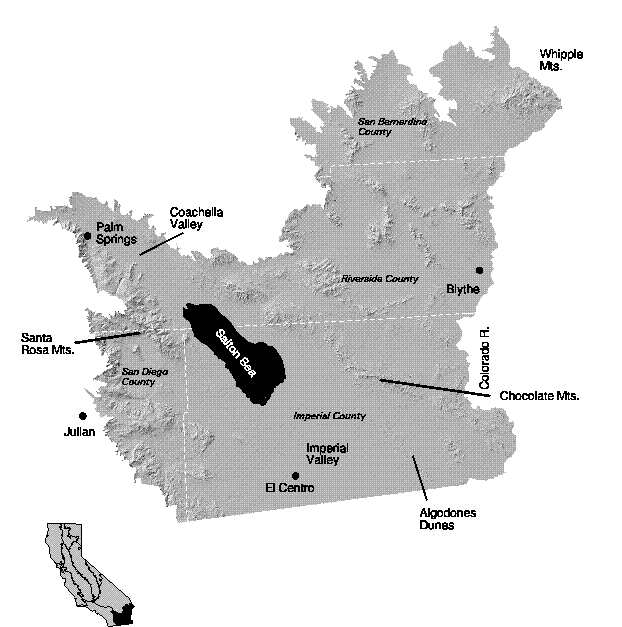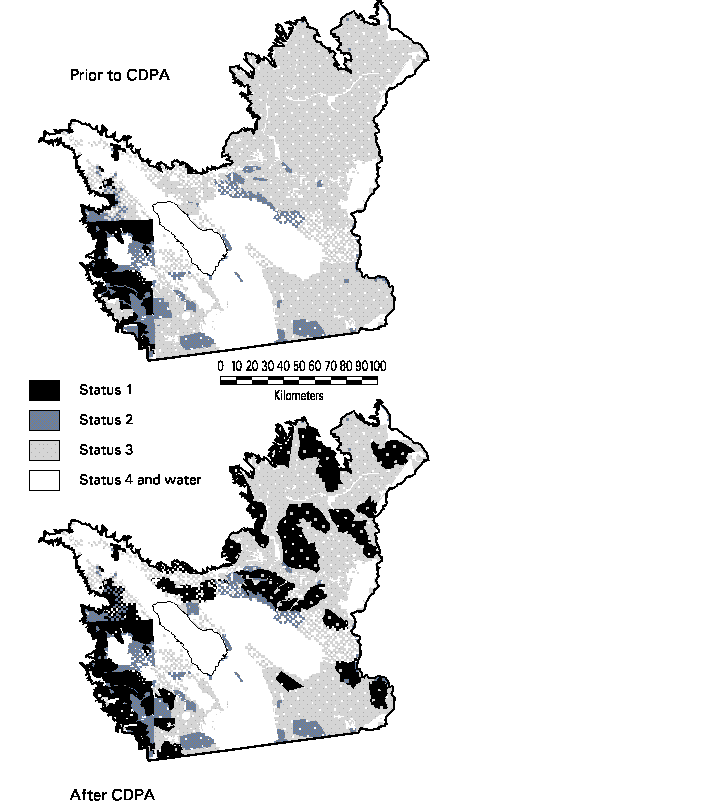
What's New
Research & Projects Publications
People
Data
Links
Appendix SON. The Sonoran Desert Region
Contributing Authors: Violet Gray, David Stoms, and Frank Davis
Regional Character
Land Stewardship
Plant Community Types
The portion of the Sonoran Desert which lies west of the Colorado River and north of the Mexican border (also known as the Colorado Desert), is characterized by low annual rainfall and extreme heat. The region covers 29,187 km² and is generally described as the drainage areas of the Salton Sea Basin and the western bank of the Colorado River Drainage (Figure SON-1). The division between the Sonoran and Mojave deserts is relatively indistinct, but generally the Sonoran region is lower, flatter and warmer (Hickman 1993).
Figure SON-1. Shaded relief image of the Sonoran Desert Region.
Because of the lack of severe winter weather, the mountains have tended to weather in place. Weathered material does not travel far, but falls short distances and collects at the base of the mountains in deep, broad bajadas. These are stable environments and though the soils are poorly developed, tending to consist mostly of large gravel and cobble, do provide one of the richest biotic environments in the region. The plains between these ranges are varied in soil structure ranging from clay to shifting sand dunes. Low elevation soils contain the finest particles of the desert environments. While clays and silts hold water well by bonding with the hydrogen atom in water molecules, they tend to hold the water so tightly in very arid environments that plants are not able to make use of the moisture. Also these soils are often alkaline because salts are carried in running water down into these basins where the water evaporates leaving minerals in the soil.
Much of the Sonoran Desert, which covers most of Arizona, and much of northern Mexico, is characterized by a bimodal pattern of rainfall. The thirty year normals for Arizona weather stations reflect a strong pattern of high rainfall during the month of August, that month being the monthly period of highest rainfall throughout the year. This pattern is largely thought to account for the lushness of the Sonoran Desert at large, and for the presence of extensive thorn and stem succulent woodlands. The thirty year precipitation normals for the Colorado Desert do show this bimodal pattern although it receives less precipitation than in Arizona. There is a strong east-west gradient in seasonal rainfall in this region of the desert with winter precipitation diminishing rapidly from west to east and summer precipitation diminishing from east to west. Summer rains in California are not nearly as pronounced as those in Arizona where many stations report considerably higher rainfall during the month of August than in January or December.
The Sonoran Desert is the most varied and floristically rich of the four American deserts. The Colorado Desert portion in California, however, has a relatively small number of perennial species, and of these, few are rare. Those perennial species which have been able to invade and persist in a particular desert habitat tend to occur as dominants wherever that habitat type recurs. The small number of perennials is made up for by a large number of herbaceous ephemerals which make up about half of the entire complement of species in the desert. The primary floristic character of this region is the overwhelming dominance of microphyllous shrubs, such as Creosote Bush (Larrea tridentata) and Burro weed (Ambrosia dumosa) across most of the plains and mesas of the desert. The upper bajadas and rocky slopes provide habitats for most of the other dominant life forms of the desert. They provide one of the richest biotic environments in the region. Many plants cannot tolerate the alkaline conditions that characterize the lowlands, so that plant species diversity increases with an increase in elevation, and then decreases again because of the poor growing conditions on the unweathered rocky slopes (Shreve and Wiggins 1964, Parker 1991). On these slopes can be found most of the stem and leaf succulents, as well as extensive stands of Ocotillo (Fouquieria splendens) . In addition they host large stands of arborescent shrubs such as Smoke Tree (Dalea spinosa), and Palo Verde (Cercidium floridum) which line the drainage reticulations and incised ravines.
Succulent species contribute strongly to the life-form variation of desert vegetation. The highest diversity of these types is along the western border of the desert in the vicinity of the Lower Borrego Valley. Wetland types are also quite diverse, and include palm oases dominated by the Fan palm (Washingtonia filifera), freshwater marshes, saltwater marshes, riparian streams, desert washes, desert arroyos, salt-impregnated playas, and saline lakes.
Much of the study area has been subjected to intensive land use. Most of the mountainous areas of the desert have been mined, some quite heavily. Urban and agricultural uses are concentrated in the low valley areas of the Salton Trough and the Colorado River Basin. In order for agriculture to be undertaken as a major industry several large aqueducts were built, effecting not only the irrigated lands, but also those lands through which the aqueducts were built. There is a strong recreational component to land use in the desert which ranges from urban resort use such as at Palm Springs, to outdoor recreation activities such as water-based sports on the Colorado River, and off-road vehicle travel and competition. The development of bajadas for ranchettes and vacation homes has caused considerable disturbance in areas of high plant diversity.
Figure SON-2. Management status of lands in the Sonoran Desert Region. See text for definitions of management levels.
Table SON-1. Area and percentage by management status level of the Sonoran Desert Region of California.
(The table compares management levels before and after the passage of the California Desert Protection Act of 1994, excluding the Salton Sea.)
Pre-bill Status Current Status Status Area (km²) % Area (km²) % 1 1,636 5.8 6,516 23.1 2 1,777 6.3 1,789 6.3 3 14,009 49.6 9,269 32.8 4 10,821 38.3 10,668 37.8 Total 28,242 100.0 28,242 100.0 The management levels are distributed unevenly across elevation zones (Figure SON-3). In particular, the lands below sea level in the Salton Trough are predominately in private ownership (84.5%), while higher elevation zones are at least 80% in public ownership. Lands below 500m elevation are represented at below average levels while those above this elevation are better represented than the regional average. Quantified as a bias index, the region shows a statistical bias in representation of elevation zones, but this bias is less than in most other regions of the state.

Figure SON-3. Comparison of the proportion of managed areas with all lands in the Sonoran Desert Region by elevation zones.
Although the CDPA certainly increased the number and area of designated areas (Figure SON-2), we were curious how much it changed the actual level of protection. For instance, did the legislation reduce the representational bias index or did it merely perpetuate any existing bias by expanding protection of well-represented environments? Since some of the new wilderness areas were already managed as Areas of Critical Environmental Concern, did the Act really increase the level of protection significantly?
The CDPA increased the representation of the region in status 1 lands from approximately 6% to 23% and increased the mean size of status 1 BMAs from 30 to 37 km². While there is still a significant bias in representation expressed by elevation zones, the bias did decrease after the legislation. The CDPA improved the representativeness of the network of BMAs in the Sonoran Desert region, but some bias still remains. This bias is of less importance, however, because most plant communities have relatively high levels of protection in current biodiversity management areas.
Table SON-2. Percent area of each CNDDB community type at each management status level in the Sonoran Desert region.
CNDDB Code CNDDB Community Name (Holland 1986) CNDDB Rank Status 1 % Status 2 % Status 3 % Status 4 % Total Mapped Distribution (km²) Status 1+2 % 22000 Desert Dunes S2.2/3.2 11.7 10.2 46.5 31.6 1,280 21.9 33100 Sonoran Creosote Bush Scrub S4 24.0 5.8 42.4 27.8 11,846 29.8 33200 Sonoran Desert Mixed Scrub S3.2 38.2 9.8 25.8 26.2 6,324 48.0 34100 Mojave Creosote Bush Scrub S4 33.6 1.7 13.8 50.8 501 35.3 34210 Mojave Mixed Woody Scrub S3.2 8.4 0.2 9.5 81.9 104 8.6 34240 Mojave Mixed Woody and Succulent Scrub S3.2 11.1 0.0 7.2 81.7 53 11.1 36110 Desert Saltbush Scrub S3.2 31.8 0.0 45.5 22.7 50 31.8 36120 Desert Sink Scrub S3.1 0.0 50.9 37.7 11.4 8 50.9 37400 Semi-Desert Chaparral S3.2 37.8 8.5 21.4 32.3 86 46.3 42200 Non-Native Grassland S4 7.0 16.0 64.4 12.6 655 23.0 46000 Alkali Playa S3.2 0.0 0.0 72.2 27.8 149 0.0 61810 Sonoran Cottonwood-Willow Riparian Forest S1.1 0.1 0.0 0.0 99.9 3 0.1 61820 Mesquite Bosque S2.1 0.1 0.0 0.0 99.9 45 0.1 62200 Desert Dry Wash Woodland S3.2 15.5 4.3 43.4 36.9 2,704 19.8 72200 Mojavean Pinyon and Juniper Woodlands S3.2/4 53.2 9.6 17.2 20.0 167 62.8 72300 Peninsular Pinyon and Juniper Woodlands S3.2 65.5 7.8 11.1 15.6 465 73.3
Region Total - Natural Communities
23,973
Region Total - All Lands
23.1 6.3 32.8 37.8 29,187 29.4
Most of the sixteen community types are relatively well represented in Status 1 or 2 management areas since the passage of the California Desert Protection Act in 1994. More than 20% of the mapped distributions of ten of the 16 types are within biodiversity management areas. The Peninsular Pinyon and Juniper Woodlands community has over 70% of its distribution in the Sonoran Desert region mapped as Status 1 or 2. The two most widespread types of the region are very well-represented: Sonoran Creosote Bush Scrub (25%) and Sonoran Desert Mixed Scrub (48%). Desert Dry Wash Woodland has just under 20% of its distribution in such managed areas. Desert Sink Scrub is currently mapped with over 50% in Status 2 areas but was only mapped over 8 km². Because this type has been largely lost to agricultural uses and the flooding of the Salton Sea, we are concerned about its long-term viability.
On the basis of management status alone, only two relatively rare types and one relatively widespread type would be of concern: Sonoran Cottonwood-Willow Riparian Forest and Mesquite Bosque, both of which were mapped almost entirely on private lands, and Alkali Playa which is predominantly on unreserved public land. The former two types are rated by the Natural Heritage Division as rare and highly threatened (California Department of Fish and Game, unpublished list, dated 4/12/91). Mojave Mixed Woody Scrub and Mixed Woody and Succulent Scrub also have less than 10% in Status 1 and 2 and over 80% in Status 4. These types however are more characteristic of the Mojave Desert region to the north where they are very well-represented and are therefore of less concern in the Sonoran region.
Page last updated 06/09/2004 21:34:21
CA-GAP Home | Overview | Report | Download GIS | CD-ROM | Site Index | National GAPTop of Page Send your comments to: stoms@geog.ucsb.edu
UCSB Biogeography Lab Home


